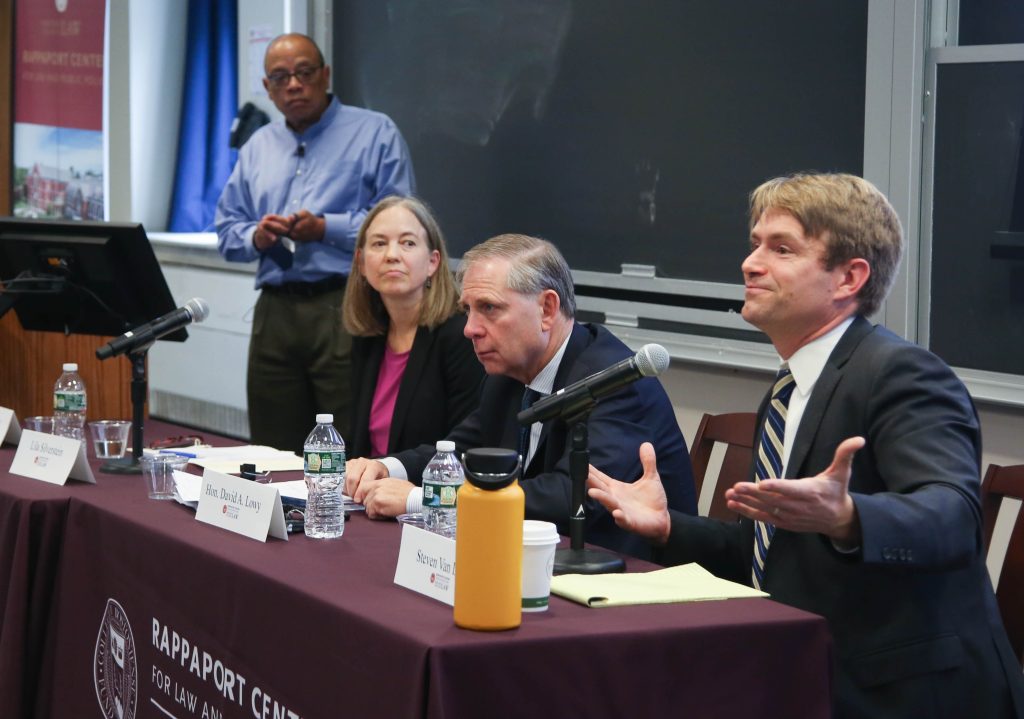The growing need for jury selection reform in courts across the United States was the subject of a Rappaport Center for Law and Public Policy panel discussion on September 11 entitled “Peremptory Challenges: Exploring Court Efforts Nationwide to Combat Racial Bias.”
During the voir dire process, attorneys on both sides of a trial can dismiss potential jurors for one of two reasons. Removal for cause applies when an attorney charges that a juror is incapable of rendering an impartial and fair verdict, and the judge agrees to the challenge. A peremptory challenge, on the other hand, gives both sides the unilateral right to dismiss a juror for any reason. Different jurisdictions limit the number of peremptory challenges available to each side depending on the type of crime.
BC Law Professor Michael Cassidy introduced the panelists and set the stage for the program by presenting a brief overview of peremptory challenges, a powerful tool for shaping the composition of a jury, held in check only by the adversary’s right to do the same. Exercised for the wrong purpose, such a tool has enabled insidious racial discrimination to go uncontested in the courtroom. In an effort to right some of these historical wrongs, some states are making changes to peremptory challenges.
The panel was led by the Rappaport Center’s Distinguished Visiting Professor, Jeffery Robinson, former deputy legal director of the ACLU and director of the ACLU Trone Center for Justice and Equality. A former public defender, Robinson now leads The Who We Are Project, an organization whose mission is to “expose the role of white supremacy and anti-Black racism throughout history up to the present.”
He was joined by the Hon. Pamela Gates, associate presiding judge for the Arizona Superior Court in Maricopa County (who appeared remotely); the Hon. David Lowy, associate justice for the Massachusetts Supreme Judicial Court; Lila Silverstein, an appellate public defender from the Washington Appellate Project in Seattle, Washington; and Steven Van Dyke, staff attorney for the Massachusetts Committee for Public Counsel Services.
Robinson walked the audience through the common-law history of peremptory challenges, charting a path from 13th century England to the landmark 1986 US Supreme Court case Batson v. Kentucky. James Batson, a Black man, was convicted of burglary by a Kentucky circuit court jury that was composed entirely of white jurors. The prosecutor had used peremptory challenges to remove each and every black potential juror from the selection pool, in alleged violation of Batson’s Sixth Amendment right to a jury of his peers. Batson forced his lawyer to object, preserving his appellate rights. The Supreme Court agreed with the allegation, and ruled that prosecutors could no longer rely on race for peremptory challenges.
Silverstein, co-author of Washington State’s General Rule 37, a law passed in 2021 to minimize or eliminate racial bias in jury selection, explained the reasoning behind the push for the new rule. “It’s far too easy for lawyers to come up with an ostensibly race-neutral reason for excluding jurors via peremptory challenge,” Silverstein said. “A lot of discrimination is unconscious or due to implicit biases, and the Batson standard doesn’t seem to reach that because it requires proof of purposeful discrimination.”
Under General Rule 37, if an attorney wants to raise an issue for peremptory challenge—such as the hostile demeanor of a potential juror—they must do so during the interview process so that the presiding judge and opposing counsel can verify or dispel that notion.
One of the main reasons Black jurors are disproportionately excluded during the voir dire process, Silverstein suggested, is that “prosecutors are going to call police officers as witnesses in the case, and they don’t want jurors who distrust the police.” She would go on to discuss how many prospective Black jurors are rightfully distrustful of police, having been victims (or having known victims) of discrimination and bias in the course of interacting with law enforcement. “The problem is that racism permeates every aspect of the justice system, including stops, arrests, searches, and so forth,” she said.
Judge Gates described a more extreme approach adopted by the Arizona Supreme Court—the complete elimination of peremptory challenges in the state. Instead of conducting extensive voir dire orally in front of a judge, Arizona has begun to adopt digital questionnaires in an effort to solicit more honest, nuanced responses from potential jurors. Instead of being asked about their opinions on police by an intimidating judge, jurors are encouraged to elaborate and discuss their feelings through the private comfort of a computer or iPhone screen.
The standout—and contradictory—moment of the panel came from Van Dyke, who narrated an elaborate day in the life from the point-of-view of a detainee on his way from prison to the courtroom for jury selection. Van Dyke solemnly described the casual ways in which the accused is made to feel dehumanized and powerless throughout the judicial process.
In Van Dyke’s telling, peremptory challenges represent one of the few, if only, occasions that the accused feels a shred of agency in the courtroom: the opportunity to remove a juror who might have racial biases themselves. “For the first time that day, you feel empowered, that you’ve actually made a choice,” he said. “After, if you’re convicted and sentenced to 18 months in the house of corrections and you serve that sentence, you don’t have to wonder, on every day of those 18 months, whether that one juror was the reason why you were convicted.”
Perhaps, Van Dyke concluded, peremptory challenges could be wielded as a tool to fight the racial bias that it has enabled in the past.


